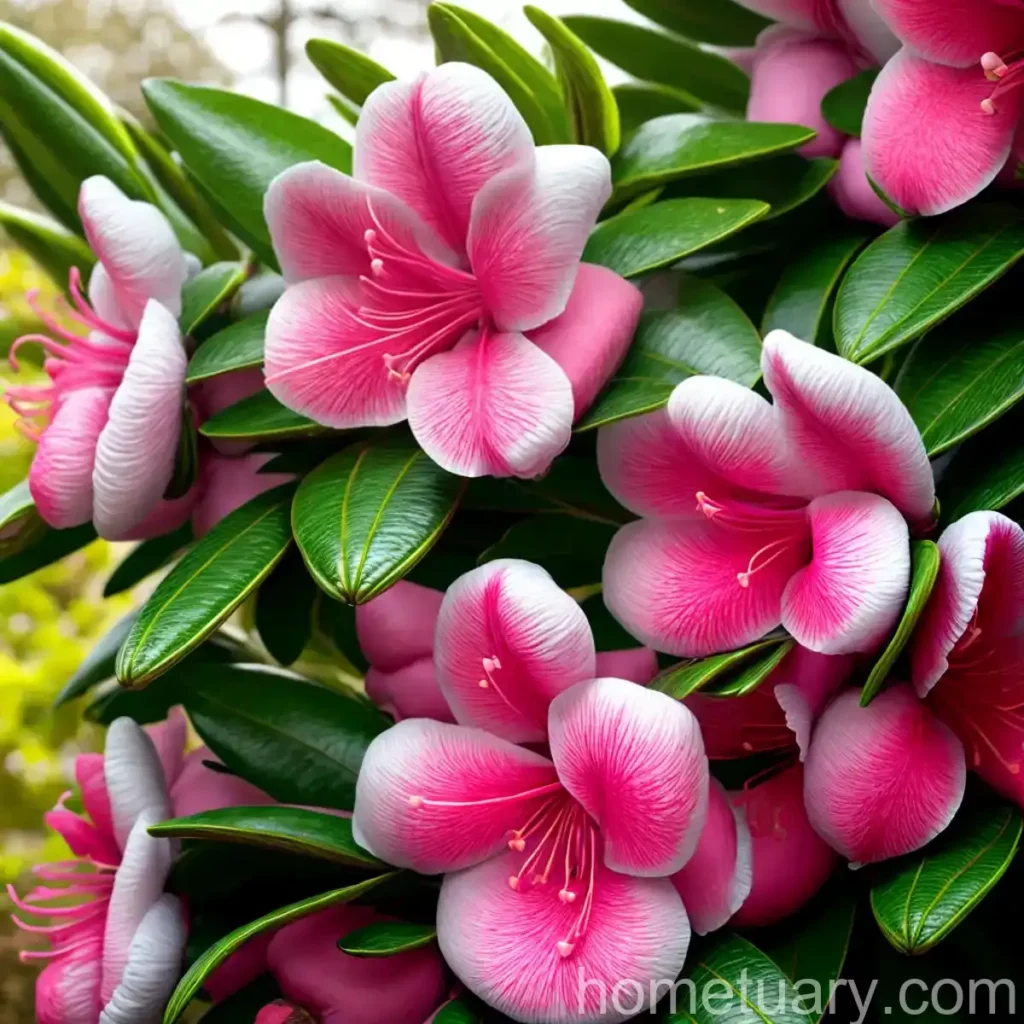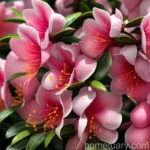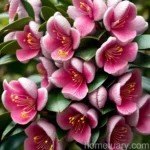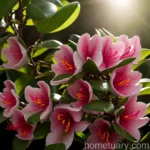Rhododendron (Rhododendron ‘Mist Maiden’): A Complete Guide
In the world of ornamental plants, rhododendrons are a popular choice for many gardeners and landscapers. Known for their stunning flowers and remarkable adaptability, the Mist Maiden rhododendron (Rhododendron ‘Mist Maiden’) is a particular variety that has gained attention for its unique characteristics and beauty. In this comprehensive guide, we will delve into the details of this cultivar, exploring everything from its cultural needs to its propagation and common diseases. Whether you are an experienced gardener or someone looking to embark on a new gardening journey, this guide will provide you with all the essential information you need to not only grow but also appreciate the beauty of the Mist Maiden rhododendron.
What is Rhododendron ‘Mist Maiden’?
The Rhododendron ‘Mist Maiden’ is a delightful cultivar known for its elegant and subtle beauty. This hybrid rhododendron is famed for its exquisite flowers, which adorn the plant during its blooming season. With its compact size and lush foliage, the Mist Maiden creates a charming presence in gardens and landscapes.
Key Takeaways – Rhododendron (Rhododendron ‘Mist Maiden’)
Before we delve into the specifics, here are the key takeaways for the Mist Maiden rhododendron:
- Plant Name: Rhododendron ‘Mist Maiden’
- Common Names: Mist Maiden rhododendron
- Cultivar Type: Hybrid rhododendron
- Blooming Season: Spring
- Growth Habit: Compact and bushy
- Flower Colors: Various shades of pinks and whites
- Sunlight Needs: Partial shade
- Hardiness Zone: 6 to 8
- Watering: Regular, adequate moisture
- Soil Type: Well-draining, acidic soil
- Size: Moderate, suitable for small gardens
- Uses: Landscaping, garden borders, and containers
With these key points in mind, let’s take a deeper look into the various aspects of caring for the Mist Maiden rhododendron.
Culture
Uses
The Mist Maiden rhododendron is a versatile plant that offers several uses in landscaping and garden settings. Here are some common uses of this cultivar:
- Garden Borders: The delicate and compact nature of the Mist Maiden makes it an excellent choice for garden borders, where its flowers can add a touch of elegance to the landscape.
- Containers: Due to its moderate size, the Mist Maiden is well-suited for container gardening. Placing it in a decorative pot on a patio or terrace can bring a beautiful focal point to the area.
- Shaded Areas: This rhododendron thrives in partial shade, making it perfect for planting under the canopy of larger trees or in areas with dappled sunlight.
Water
Like many rhododendron varieties, the Mist Maiden requires regular watering to maintain adequate moisture levels in the soil. While it does not like to be waterlogged, it is important to ensure that the plant receives sufficient water, especially during dry periods. Here are some essential watering tips for the Mist Maiden rhododendron:
- Water the plant deeply but infrequently to encourage deep root growth.
- Apply mulch around the base of the plant to help retain soil moisture.
- During the hot summer months, check the soil moisture regularly and water as needed to prevent the soil from drying out completely.
Sunlight
The Mist Maiden rhododendron thrives in partial shade, making it an ideal choice for areas with filtered sunlight or dappled shade. When selecting a location for planting, consider the following sunlight requirements:
- Partial Shade: Choose a spot that receives morning sun and afternoon shade. Avoid planting in areas with direct, intense sunlight for prolonged periods.
- Filtered Light: Under the canopy of larger trees or near structures that provide dappled sunlight are excellent locations for the Mist Maiden.
Fertilizer
Proper fertilization is essential for the healthy growth and blooming of the Mist Maiden rhododendron. The following guidelines can help ensure that your plant receives the necessary nutrients:
- Use a balanced, slow-release fertilizer specifically formulated for acid-loving plants.
- Apply the fertilizer in early spring before new growth begins, following the manufacturer’s instructions for application rates.
- Avoid excessive use of fertilizers high in nitrogen, as this can lead to lush foliage growth at the expense of flower production.
Soil
The quality of the soil is crucial for the overall health and vigor of the Mist Maiden rhododendron. Here are some important factors to consider when it comes to soil requirements for this cultivar:
- Acidic pH: Rhododendrons thrive in acidic soil with a pH ranging from 4.5 to 6.0. Conduct a soil test to determine the pH of the planting area and amend the soil as needed to maintain suitable acidity.
- Well-Draining: Good drainage is essential to prevent waterlogged conditions, which can lead to root rot. Incorporate organic matter such as peat moss or compost into the soil to improve drainage.
Pruning
Pruning is an important aspect of rhododendron care, helping to maintain the plant’s shape, remove dead or diseased branches, and encourage healthy growth. When it comes to the Mist Maiden rhododendron, the following pruning techniques are recommended:
- Deadheading: Remove spent flowers after the blooming season to promote new growth and maintain a tidy appearance.
- Rejuvenation Pruning: If the plant becomes leggy or overgrown, rejuvenation pruning can be carried out in late winter or early spring to encourage new growth and a more compact form.
- Minimal Trimming: Overall, the Mist Maiden rhododendron requires minimal pruning, as it naturally maintains a well-rounded shape.
Propagation
Propagating the Mist Maiden rhododendron allows you to create new plants from existing ones, whether for expanding your garden or sharing with fellow gardening enthusiasts. Here are two common methods for propagating this cultivar:
- Cuttings: Take semi-ripe cuttings in mid-summer, choosing healthy shoots with firm stems. Dip the cut ends in a rooting hormone and plant them in a well-draining propagation medium. Keep the cuttings moist and warm until they develop roots.
- Layering: In late spring or early summer, select a low-growing branch and nick the underside of the stem. Bury the wounded portion in the soil, keeping it moist until roots develop. Once well-established, the new plant can be separated from the parent.
Container Popularity
The compact size and attractive blooms of the Mist Maiden rhododendron make it a popular choice for container gardening. When growing this cultivar in containers, it is essential to consider the following factors:
- Container Size: Choose a container that provides ample space for the plant’s roots to grow, but avoid using an excessively large pot, as this can retain too much moisture.
- Drainage: Select a container with drainage holes to prevent waterlogging.
- Soil: Use a well-draining, acidic potting mix formulated for rhododendrons and azaleas.
Common Diseases
Rhododendrons, including the Mist Maiden cultivar, are susceptible to several common diseases that can affect their health and appearance. Understanding these diseases and their symptoms is crucial for early detection and appropriate treatment. Some common diseases that may affect the Mist Maiden rhododendron include:
- Powdery Mildew: Identified by a white powdery coating on the leaves, powdery mildew can weaken the plant and inhibit growth.
- Leaf Spot: Circular or irregular spots on the leaves are indicative of this fungal disease, which can lead to leaf drop and reduced vigor.
- Phytophthora Root Rot: This soil-borne pathogen can cause root rot, leading to wilting, yellowing leaves, and eventual plant death if left untreated.
Disease Diagnosis
When diagnosing diseases in the Mist Maiden rhododendron, it is important to closely inspect the plant for any signs of damage or discoloration. Additionally, monitoring changes in the plant’s growth and overall appearance can help in identifying potential disease issues. If you suspect a disease problem, it is advisable to consult with a plant health specialist or a local extension office for accurate diagnosis and treatment recommendations.
Common Pests
In addition to diseases, rhododendrons can also be vulnerable to pest infestations. Some common pests that may affect the Mist Maiden rhododendron include:
- Spider Mites: These tiny pests can cause stippling and discoloration of the leaves, often leading to an overall decline in plant health.
- Azalea Lace Bug: Characterized by stippled and discolored leaves, lace bug infestations can weaken the plant over time.
- Caterpillars: Certain caterpillar species may feed on the foliage of rhododendrons, causing visible damage to the leaves.
To manage pest infestations, regular monitoring and early intervention are key. Natural predators, such as ladybugs and predatory mites, can help keep pest populations in check. For severe infestations, targeted insecticidal treatments may be necessary.
Botanist’s Tips
For those seeking to create an optimal environment for the Mist Maiden rhododendron, here are some insightful tips from botanists and horticulturists:
- Mulching: Applying a layer of organic mulch around the base of the plant helps maintain soil moisture and regulates soil temperature.
- Winter Protection: In regions with cold winters, providing winter protection, such as burlap wraps or windbreaks, can shield the plant from harsh temperatures and drying winds.
- Companion Plants: Pair the Mist Maiden with other shade-loving plants, such as hostas, ferns, and heucheras, to create visually appealing and diverse garden landscapes.
Fun Facts
To deepen our appreciation for the Mist Maiden rhododendron, here are some intriguing and fun facts about this captivating plant:
- The Mist Maiden rhododendron is a result of the hybridization of select rhododendron species, combining desirable traits from each parent plant.
- This cultivar is known for its ability to attract pollinators, including bees and butterflies, adding to the ecological value of garden spaces.
- In some cultures, rhododendrons are symbolic of beauty, grace, and enduring love, making them popular choices for special occasions and celebrations.
Links to External Resources
For further information and resources on caring for the Mist Maiden rhododendron, the following links provide valuable insights and guidance:
- American Rhododendron Society
- Royal Horticultural Society – Rhododendrons and Azaleas
- University of Maryland Extension – Growing Rhododendrons and Azaleas
In conclusion, the Mist Maiden rhododendron is a captivating and versatile plant, offering a wealth of ornamental value to gardens and landscapes. By understanding its specific cultural needs, engaging in proper care and maintenance, and recognizing potential challenges, we can foster the health and beauty of this charming cultivar. Whether adorning garden borders, adding allure to container displays, or enhancing shaded landscapes, the Mist Maiden rhododendron invites us to appreciate the splendor of nature’s botanical treasures.
With this comprehensive guide, gardeners and enthusiasts alike can embark on the journey of growing and nurturing the Mist Maiden rhododendron with confidence and appreciation for its unique qualities and contributions to our natural surroundings.















